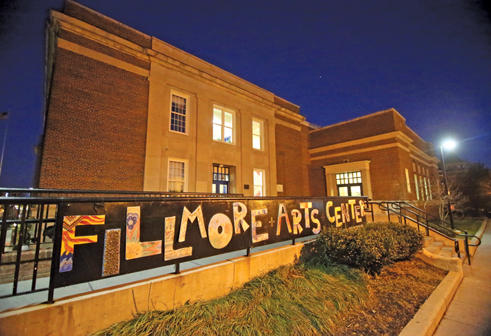Despite One-Year Reprieve, Fillmore Parents Battle to Preserve Arts Program

By Brady HoltCurrent Staff Writer
The Fillmore Arts Center has received a one-year reprieve from D.C. Public Schools, which agreed to continue the popular-but-pricey program through the end of the next school year but has vowed to terminate it for fall 2017.
Parents learned only recently of the initial decision to eliminate Fillmore this coming school year. They decried both the loss of the program — which provides weekly arts instruction to about 1,700 students at Hyde-Addison, Key, Reed, Ross and Stoddert elementary schools — and the lack of notice.
The school system has repeatedly cited the program’s cost as a reason to terminate it, but officials said they can be flexible about the timing.
“We extended funding for the Fillmore Arts Program for one more year to allow the five participating schools and their communities to have ample time to transition bringing arts education into their schools,” D.C. Public Schools spokesperson Michelle Lerner wrote in an email to The Current. “We heard [from] our communities that they needed more time for this transition, and it was something we were able to solve for one more year. … We will use the next year to work with school principals to ensure a smooth transition to in-house arts programming, and look forward to communicating with the community on this transition.”
But parent leaders say the only option is for the program to continue further, and they vowed to lobby for that approach.
“The reality is that DCPS has no plan to solve any of the problems that were created by their rush to kill Fillmore in the first place,” said John Claud, president of Friends of Fillmore and a Stoddert parent. “Their position is they’re going to work with the schools and figure out how to do that. But there’s a solution for that: It’s called Fillmore, and it works great.”
Founded in 1974, the Fillmore Arts Center offers a centralized location for arts education, in Georgetown’s Hardy Middle School. It offers students access to more specialized resources, facilities and instruction than they’d receive from a single art teacher assigned to their own school. Supporters say the center also helps alleviate space shortages at the participating elementary schools.
However, the program also costs more than individual art teachers. The five schools allocate their collective $1 million arts funding to Fillmore to cover instructors’ salaries, and the school system covers the costs of administering the program, transporting students and purchasing supplies. D.C. Public Schools has estimated that Fillmore costs more than $1,100 per pupil per year, versus less than $500 for in-house arts instruction.
Schools Chancellor Kaya Henderson testified at a D.C. Council hearing last month that the greater expense wasn’t necessary or appropriate because relatively few schools participate, as opposed to the majority that handle arts education on their own.
“When it was schools across the city, the financial modeling made a lot of sense, and it was able to pay for itself,” Henderson testified. But with fewer schools participating, “at some point the model becomes financially unviable, and every year we see more and more schools saying ‘I’m going to pull out of Fillmore and do it myself’ or what have you. So, we can’t keep supporting this program at this level.”
Lerner, the school system spokesperson, added that the conventional arts model also has proved effective.
“All of our elementary schools (with the exception of the five schools that currently participate in Fillmore) have robust, in-house arts education,” Lerner wrote. “We are confident that these five schools can provide programming that includes working with clay, sculpture, print making, photography, installation art, strings instruction, piano instruction, and even rock bands that exists in our elementary schools.”
Claud, of the Friends of Fillmore, worries that depiction is unrealistic for the overcrowded Northwest schools that now use Fillmore.
“The cost of expanding these schools even more to accommodate what they need pales in comparison, I would bet, to what it costs to operate Fillmore,” he said. Claud also estimates that the cost difference is less than the school system suggests — especially after officials implement a planned transition away from a costly transportation contract — and said the number of schools participating in Fillmore hasn’t declined in many years.
And although officials say it’s unfair for some students to receive more arts funding than others, Ward 3 Council member Mary Cheh countered at the March 4 hearing that per-pupil funding isn’t the only issue.
“I think the fairness and equity argument cuts a different way,” Cheh said. “I would say keep this while the schools that are still going to Fillmore are ones that are so overcrowded that they don’t have dedicated space for arts.”
Elizabeth Wise, co-president of the Key Elementary PTA, said the space shortage there isn’t being overblown: “Key already houses the fifth grade in trailers and at least one staffer is housed in what was once a closet,” she wrote in an email.
Wise and Claud both fear that schools will be left with “art on a cart,” rather than the rich education students now benefit from.
“You can’t push a diverse program into schools — you can’t move strings, you can’t move theater space, you can’t move a dance studio, you can’t move a kiln,” Claud said. “DCPS doesn’t have a solution for that, and there probably isn’t one. So the answer is you get less arts.”
Henderson said at the hearing that she’s open to finding “creative ways” to fund Fillmore, such as a public-private partnership or fundraising events comparable to those held by Duke Ellington School of the Arts. “We have to find a different financial model, or more schools have to decide they want in,” she said.
This article appears in the April 13 issue of The Georgetown Current newspaper.
